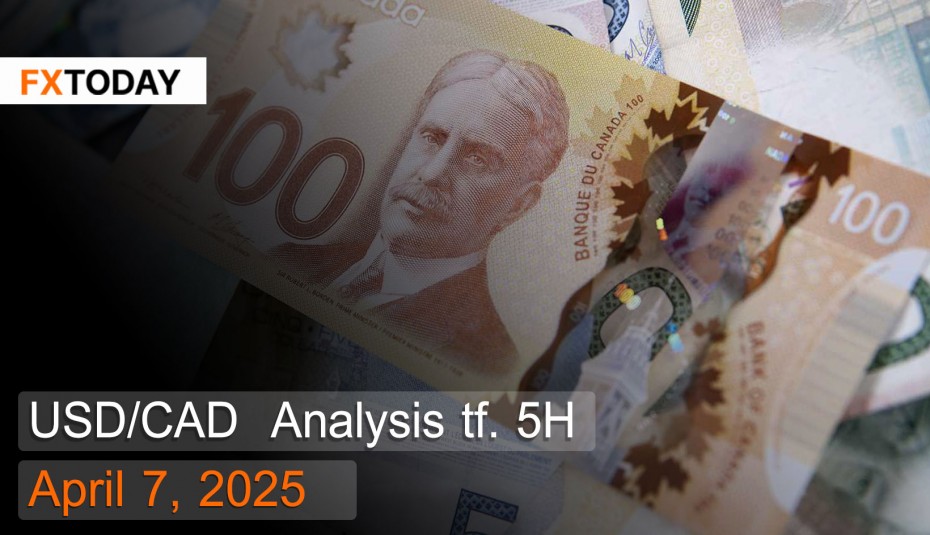Canada May Face a Recession.
The Canadian dollar weakened again, marking a continued decline from its four-month high amid signs of economic fragility and rising external trade uncertainties. Meanwhile, an increase in job seekers has caused the unemployment rate to rise rapidly, reflecting a weakening labor market that could impact the economy in the long term. At the same time, crude oil prices — which support the country’s export sector — fell by more than 7% due to concerns about a supply glut from OPEC+ and escalating global trade tensions. Although the Canadian dollar initially benefited from new U.S. protectionist tariffs, intensifying trade disputes, especially regarding automobile import tariffs, have left investors worried about the current state of the economy.
Canada’s unemployment rate rose to 6.7% in March, accelerating from a three-month low, with the number of unemployed persons increasing by more than 36,100, reflecting a cooling labor market. Most of the newly unemployed were older workers aged 55 and above. Meanwhile, net employment fell by over 32,600 positions, with full-time jobs plummeting by as many as 62,000 positions, divided between 48,000 jobs lost in the private sector and 14,000 in the public sector. This shows a rapid contraction of private sector businesses, with the wholesale and retail trade sectors being the hardest hit.
Canada’s services PMI dropped to 41.2 in March, indicating a contraction in the service sector for the fourth consecutive month, as new business fell sharply due to tariff concerns, which also impacted customers' spending power. This anxiety also led to reduced capacity demand and partial layoffs. On the cost side, raw material inflation rose to its highest level since 2023, driven by increasing labor costs and higher supplier fees.
The manufacturing PMI also declined to 46.3 in March from 47.8 the previous month. The slowdown in manufacturing activity was pressured by contractions in both output and new orders, as companies observed that customers were becoming more cautious with their spending amid ongoing tariff-related uncertainties concerning paper goods and the U.S. As a result, new export orders dropped to their lowest level since 2020, forcing factories to delay hiring in an effort to better control costs. Amid rising tariffs, companies developed a strongly negative outlook for future business, expecting further production declines next year.
Canada’s 10-year government bond yield fell below 2.92% in early March as investors increasingly sought safe-haven assets to cope with rising risks of a global recession, exacerbated by U.S. tariff measures. President Trump's announcement of a 10% baseline tariff on all imported goods, with even higher rates for some key trading partners, heightened concerns about a slowdown in U.S. economic activity and potential retaliatory measures. This uncertainty was further fueled by slowing domestic economic data, including a sharp drop in the composite PMI to its lowest level since 2020, increasing demand for Canadian government bonds and thus driving yields lower.
Techical analysis data (5H)
Resistance: 1.4288, 1.4351, 1.4405
Source: Investing.com
Buy/Long 1: If the price touches support in the price range of 1.4117 - 1.4171 but cannot break the support at 1.4171, you may set a TP at approximately 1.4351 and SL at around 1.4054 or according to your acceptable risk.
Buy/Long 2: If the price breaks the resistance in the price range of 1.4288 - 1.4351, you may set a TP at approximately 1.4405 and SL at around 1.4117 or according to your acceptable risk.
Sell/Short 1: If the price touches resistance in the price range of 1.4288 - 1.4351 but cannot break the resistance at 1.4288, you may set a TP at approximately 1.4117 and SL at around 1.4405 or according to your acceptable risk.
Sell/Short 2: If the price breaks the support in the price range of 1.4117 - 1.4171, you may set a TP at approximately 1.4054 and SL at around 1.4351 or according to your acceptable risk.
Pivot point April 7, 2025 10:35 PM. GMT+7
|
Name
|
S3
|
S2
|
S1
|
Pivot Points
|
R1
|
R2
|
R3
|
|---|---|---|---|---|---|---|---|
| Classic | 1.4054 | 1.4117 | 1.4171 | 1.4234 | 1.4288 | 1.4351 | 1.4405 |
| Fibonacci | 1.4117 | 1.4162 | 1.4189 | 1.4234 | 1.4279 | 1.4306 | 1.4351 |
| Camarilla | 1.4193 | 1.4204 | 1.4214 | 1.4234 | 1.4236 | 1.4246 | 1.4257 |
| Woodie's | 1.405 | 1.4115 | 1.4167 | 1.4232 | 1.4054 | 1.4349 | 1.4401 |
| DeMark's | - | - | 1.4144 | 1.4221 | 1.4261 | - | - |
















